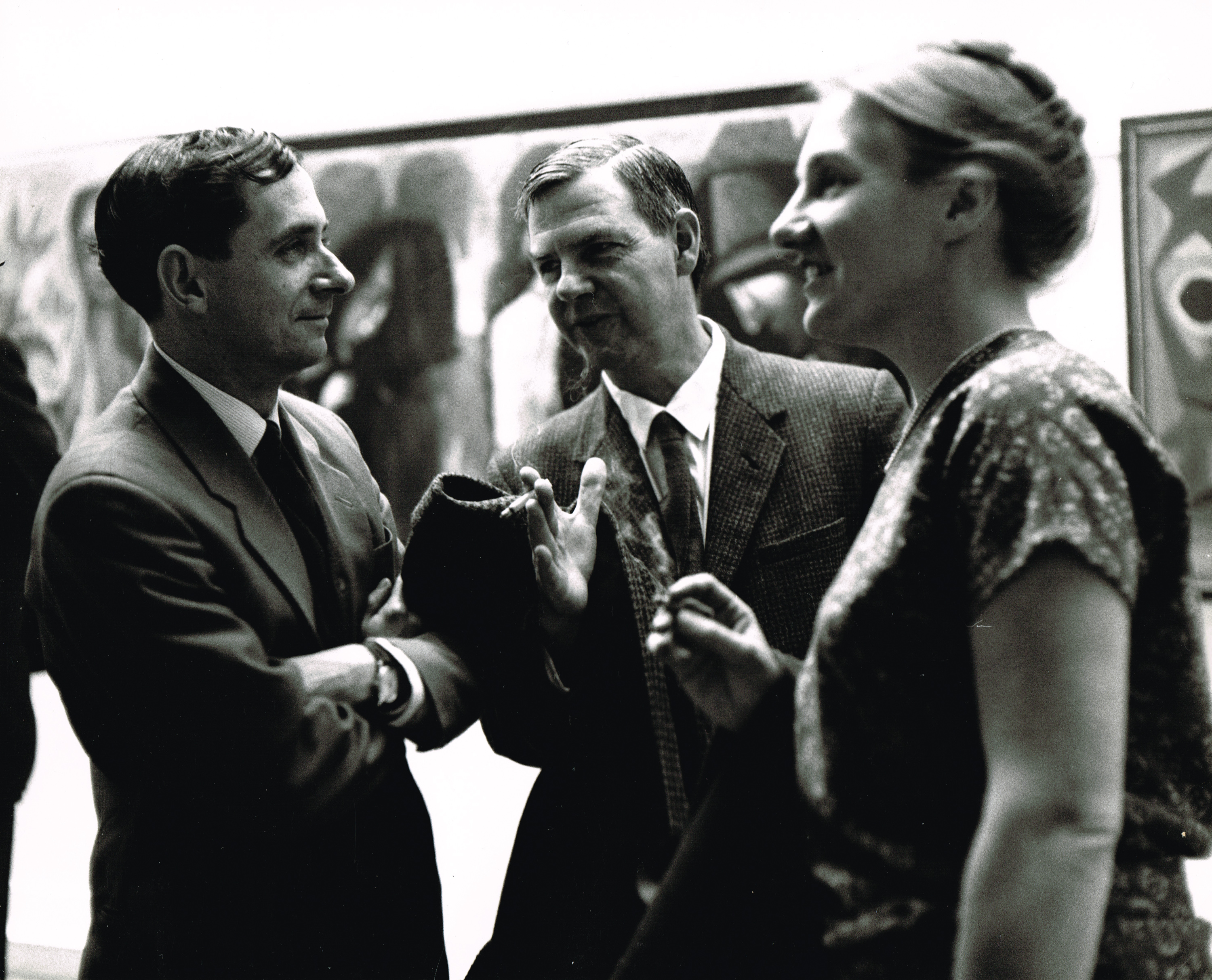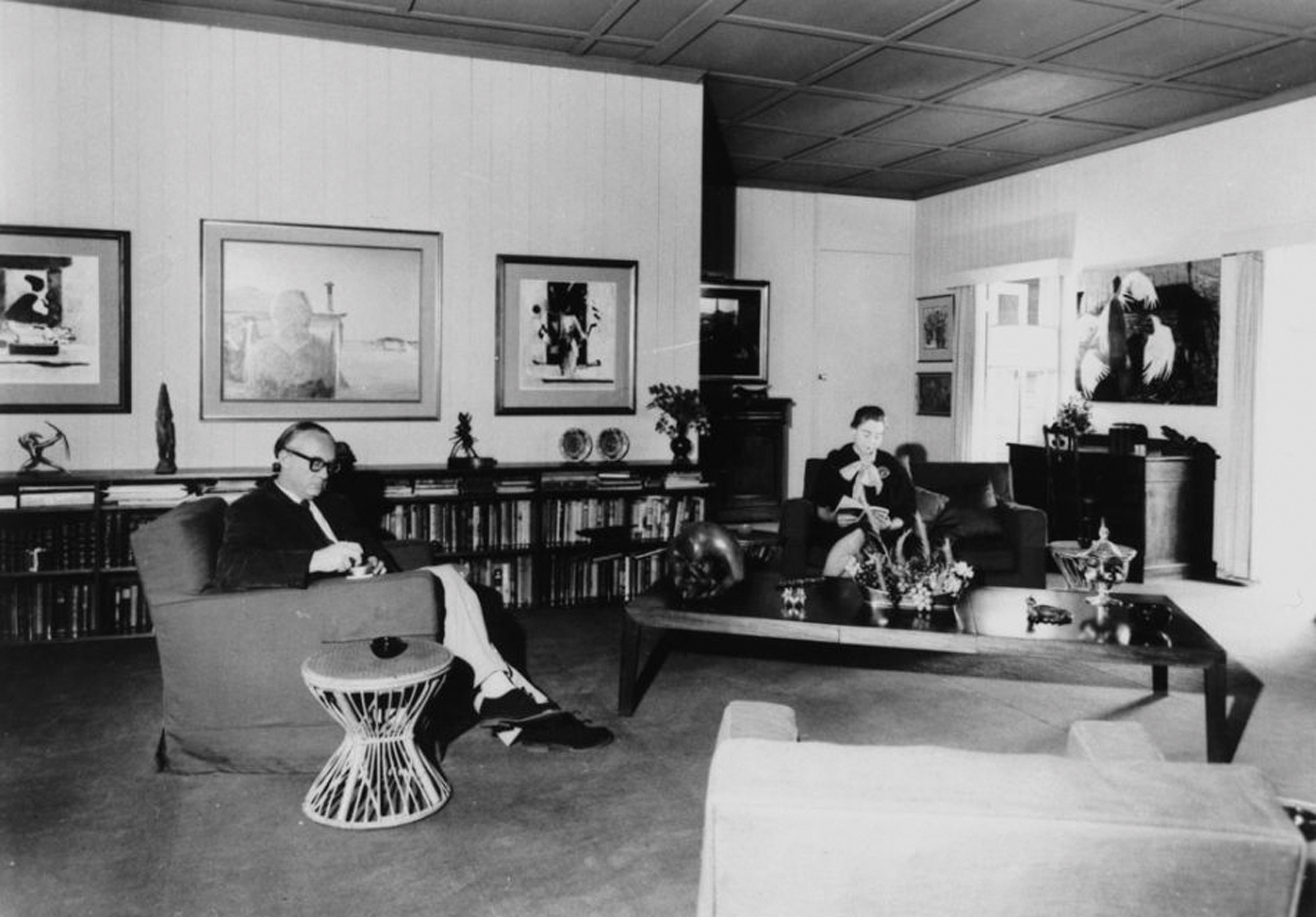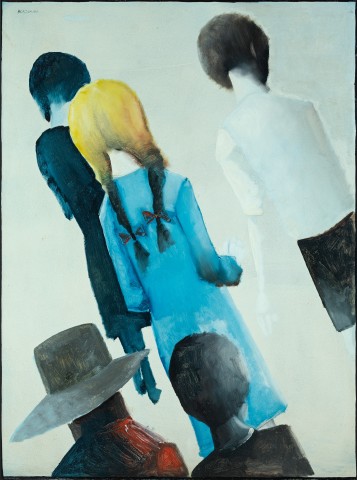ASCENDING CHILDREN, 1960
CHARLES BLACKMAN
oil on composition board
122.0 x 91.0 cm
signed upper left: BLACKMAN
Brian and Marjorie Johnstone, Brisbane, by 1967
Marjorie Johnstone, Brisbane, 1992
Private collection, Brisbane, a bequest from the above in 1994
Shapcott, T., Focus on Charles Blackman, University of Queensland Press, Brisbane, 1967, pp. 52, 53 (illus., dated 1961)
Shapcott, T., The Art of Charles Blackman, Andre Deutsch, London, 1989, pl. 88, pp. 149 (illus., dated 1961), 255 and illus. back cover
St John Moore, F., Charles Blackman. Schoolgirls and Angels, National Gallery of Victoria, Melbourne, 1993, p. 20
Charles Blackman, Arthur Boyd and Barbara Blackma

at the opening of the exhibition Recent Australian Painting,
Whitechapel Gallery, July 1961
‘(Charles Blackman) has produced a large quantity of serious work at an age when most artists have not even approached their formative period. His work has imaginative power and a strong poetic bias… the curiously evocative quality of nearly all Blackman’s painting could easily carry this artist on to a very special place in the Australian art of our time.’1
Writing in Meanjin in 1952 after visiting Blackman’s first exhibition, an informal display of works pinned up on the walls of the coach house where he lived in the Melbourne suburb of Hawthorn, the artist and art critic Alan McCulloch was impressed. So too, were John and Sunday Reed, keen and informed supporters of modern art who had met the aspiring young artist several years earlier and purchased two paintings and a drawing. Blackman’s work also garnered support from his artistic peers, with Danila Vassilieff buying two pictures, remarking, ‘The bit I like about you is the bit with love in your heart.’2
Blackman’s first solo exhibition in a commercial gallery took place the following year at the Peter Bray Gallery in Melbourne and included a group of his Schoolgirl paintings, which are now regarded as one of the most significant groups of modern works produced in Australia during the immediate post-war years. The later 1950s saw the creation of the iconic Alice series, and the renowned, evocative paintings of faces and flowers. Blackman’s ability to imbue his pictures with a palpable sense of humanity and emotion was by then widely recognised. As Gertrude Langer wrote in response to his 1958 exhibition in Brisbane, ‘his art… speaks tenderly of suffering and joy, dreams and memories. His colours, brilliant as they are, are not employed for their own sake, but for their emotional import... a painter who speaks to the heart is to be treasured.’3
By the late 1950s, Blackman’s star was in the ascendant. One of his Alice paintings was acquired by the Museum of Modern Art in Paris in 1958, and in 1959 he won the Rowney Prize for drawing. His June 1960 exhibition at the Johnstone Gallery – which by that time had been relocated to the stylish Bowen Hills home of its founders, Brian and Marjorie Johnstone – sold out, realising about £4500 and enabling the Blackmans to buy a house in St Lucia.4 Two months later Blackman was awarded the prestigious Helena Rubinstein Travelling Scholarship and by the following February, he and his family had relocated to London, where they lived for the next five years. 1961 saw three of his works, including Dreaming in the Street, 1960 (National Gallery of Victoria) shown in Recent Australian Painting, the groundbreaking exhibition curated by Bryan Robertson at the Whitechapel Gallery. That same year he represented Australia alongside Brett Whiteley at the Biennale des Jeunes in Paris, and in 1963, was included in a major historical survey of Australian art mounted by the Tate.
Ascending Children, 1960 was painted just before Blackman left for London and shows an artist in full creative flight. While the blue dress and golden hair of the central figure recall Blackman’s depiction of Alice in Wonderland, the others subtly allude to his schoolgirls. Indeed, the unusual composition, in which the figures all lean in harmonious unison to the left, was inspired by the sight of children walking to school up a steep Brisbane street.5 The handling of paint is assured, moving seamlessly from passages that are urgent and expressive – such as the figures in the foreground – to others which are realised with the utmost delicacy. Look, for example, at the soft, blurred edges of the figures’ heads and the ethereal quality of the girl on the right, who emerges, almost ghost-like, from the painting’s pale ground. Writing in the 1967 monograph on Blackman, Thomas Shapcott rhapsodised, ‘There is a new assurance about such a painting as Ascending Children which gives it a luminosity no words… can approach… there is a true serenity in this work.’ He continued: ‘Ascending Children… has a quietness and grace, a gentleness of shape and shade, that assures it of ranking among the most successful essays in this field… (Blackmans’) children walk easily, beautifully, forwards and onwards. It is as if the painter were permitting the frailty of the moment to move to the surface and be caught, in exultation only, in its own sufficiency… What makes the painting truly remarkable, is, of course, the subjecting of diagonal line, in the total picture, to this mood: the mastery of total mood over the technical restraints of pre-ordained dynamic.’6
Brian and Marjorie Johnstone

This painting has an excellent provenance, owned by Brian and Marjorie Johnstone from the 1960s, and then bequeathed to a friend – the current vendor – upon Marjorie’s death in 1994.
1. Alan McCulloch writing in Meanjin, February 1952, cited in Shapcott, T., The Art of Charles Blackman, Andre Deutsch, London, 1989, p. 9
2. Danila Vassilieff, cited in St John Moore, F., Charles Blackman: Schoolgirls and Angels, National Gallery of Victoria, Melbourne, 1993, p. 17
3. Gertrude Langer writing in the Courier Mail, Brisbane, 18 November 1958, cited in Shapcott, T., Focus on Charles Blackman, University of Queensland Press, St Lucia, 1967, p. 37
4. Shapcott, ibid., p. 48
5. St John Moore, op. cit., p. 20
6. Shapcott, 1967, op. cit., p. 52
KIRSTY GRANT
